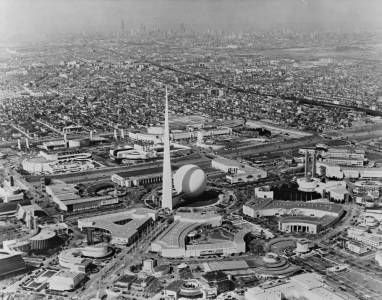dieser beitrag wurde verfasst in: englisch (eng/en)
titel: The World of Tomorrow (New York World's Fair 1939)
jahr: 1939–40
adresse: Flushing Meadows Corona Park, Queens, New York, NY, USA
+: «[…] Meanwhile, at the end of 1935 a group who styled thenselves as 'progressives in the arts' became alarmed lest the coming World's Fair be captured entirely by commercial interests and a great opportunity for public education be lost. The group – mostly architects, designers, artists, and city planners – organized a dinner on December 11, 1935, and invited Lewis Mumford, an architectural critic, urbanist, and public intellectual, to address them on the topic of the proposed 1939 World's Fair.
Mumford's address had a dramatic effect. He argued that most fairs, including the monumentally successful Chicago Fairs of 1893 and 1933, oriented themselves toward recounting the achievements of the past; the coming fair should look to the building of a new and better future. It would be a blunder, he said, 'to permit it to design itself according to the bids of the highest bidder.' He went on to say that 'although the industrial story it an important story to tell in the Fair […] it is by no means the shole story.' To tell the 'dead story of how wonderful the machine is […] is not a coherent story and not one which has any educational […] cultural [or] dramatic value today.' What was needed was something very different. 'The story we have to tell […] is the story of this planned environment, this planned industry, this planned civilization. If we inject that notion as a basic notion of the Fair […] we may lay the foundation for a pattern of life which will have an enormous effect in times to come.' The group formed a new committee, the 'Fair of the Future 1939 Committee,' whose manifesto echoed the December 11 proceedings: 'The Chicago Fair looked back over a Century of Progress; the New York Fair should look forward to a Century in the Making. By producing a Fair of the Future, New York will help create the America of the Future. […] Because Fairs of the past have been retrospective, because their theme has been manufacturers and merchandise and not the social conciousness […] new processes and products, they have lacked architectural unity and significance.' This manifesto was signed by Mumford, Alfred Barr of the Museum of Modern Art, the designers Henry Dreyfuss, Raymond Loewy, and Walter Dorwin Teague, and the architect Edward Durrell Stone, among others. (Kargon et al. 2015, p. 61–62)
